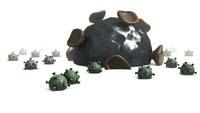A giant in the world of dwarfs
2010/10/01 Roa Zubia, Guillermo - Elhuyar Zientzia Iturria: Elhuyar aldizkaria

In 1992 a giant appeared in microscopes. It was discovered in an industrial cooling system in the city of Bradford, where microbiologists discovered if the amoebas of its waters were infected with a legionella that was studying, and that the legionella was replaced by a giant inside the amoebas.
However, microbiologists did not know that he was a giant. It looked like a bacterium because it was the size of a bacterium. In addition, a classic bacterial classification test was performed, the Gram stain test, which was classified as positive Gram bacteria. And they gave him the name of bacteria: Bradfordcoccus. Eleven years later, researchers at the University of Marseille in France found that the bacteria was a virus, a giant virus.
He was changed the name, by imitating a bacterium in the Gram stain he was called Mimibirus. And the name is very appropriate, because from different points of view it imitates living beings; for example, it imitates the very characteristic of being alive.
Biologists put the limit of life between bacteria and viruses. Bacteria are living things, viruses are not. But Mimibirusa is in an intermediate territory. It is a virus that carries out a series of activities that traditional viruses do not. It has the behavior of almost a bacterium, but it does not get to it either. It is at the limit of life, but in what area?
As for size, it is huge; some bacteria are smaller, and if we compare it to other viruses, the giant is well deserving. It has a diameter of 800 nanometers ten times greater than the conventional virus. And that makes it special. For example, they have recently discovered that there are viruses that are capable of infecting Mimibvirus itself, that is, they are inside. But the big size does not make it alive.
Mimibirus is large, not only in size, but in genetic material; the genome of Mimibirus is also giant. In conventional viruses the number of genes is very variable, but few have more than one hundred genes and some have less than ten. Mimibirus has 911 genes in the DNA molecule it contains.
No need for kernel
This number of genes is almost independent of Mimibvirus. That is, conventional viruses are not able to reproduce because they have no life, they do not have the genes that deal with it. It is the cells of living things that are infected to take advantage of these genes, the new number of viruses generates reproductive mechanisms. And this mechanism is found in the nucleus of the cell, unless the living being is a bacterium. But the researcher at the Genetic Information and Structure Laboratory of Marseille, Jean Michel Claverie, has discovered that Mimibirus has another behavior. It does not use the nucleus of the cell that infects, but has some own genes to reproduce. Therefore, it receives infections of other viruses, although biologists do not understand perfectly how this infection can advance.
When mimibirus infects an amoeba, it creates a structure for the creation of new specimens in the cell cytoplasm, a virus "factory", according to Claverie. And install this factory outside the core of the amoeba, as it does not need its reproductive system. But at the same time, the cytoplasm of the amoeba is absolutely necessary. For example, amino acids must be acquired from there to obtain proteins. And it has genes to produce proteins that transport the ATP molecule, but this ATP should be taken from the cytoplasm of the amoeba (the molecule that stores the ATP energy, which stores the energy needed for most of the cell's chemical reactions). That is, the Mimibirus has a reproductive mechanism but not complete.
Seen otherwise, Mimibirus behaves like a nucleus, but when the cytoplasm is missing, he steals another cell. Yes, as a result of the proliferation, more "cores" have emerged and we must go in search of other cytoplasms outside the mother that have been formed.
It is a nucleus that copies itself, but has no capacity to produce cytoplasm. It has its own reproductive system, but it cannot reproduce without the help of another. So, is it alive? Yes or no, according to the definition of life used.
There is no doubt that in virus classifications, Mimibirus must be within a family of its own, which is Mimiviridae. But according to the classic classification, if we classify this family along with viruses, we are assuming they are not living beings and that is not so clear. Some experts say they must be classified in a group other than viruses and bacteria. The name of Girus for the viruses of this group (Giant virus, giants) has also been proposed. And, perhaps, this group could be integrated into the whole of living beings.
Apart from the debate about whether he is alive, Mimibirus can also play a role in speculations about the origin of the core. Today's complex cell nucleus could be a gigantic virus of yesteryear.

Gai honi buruzko eduki gehiago
Elhuyarrek garatutako teknologia




